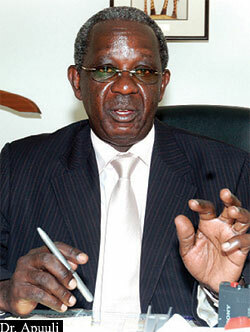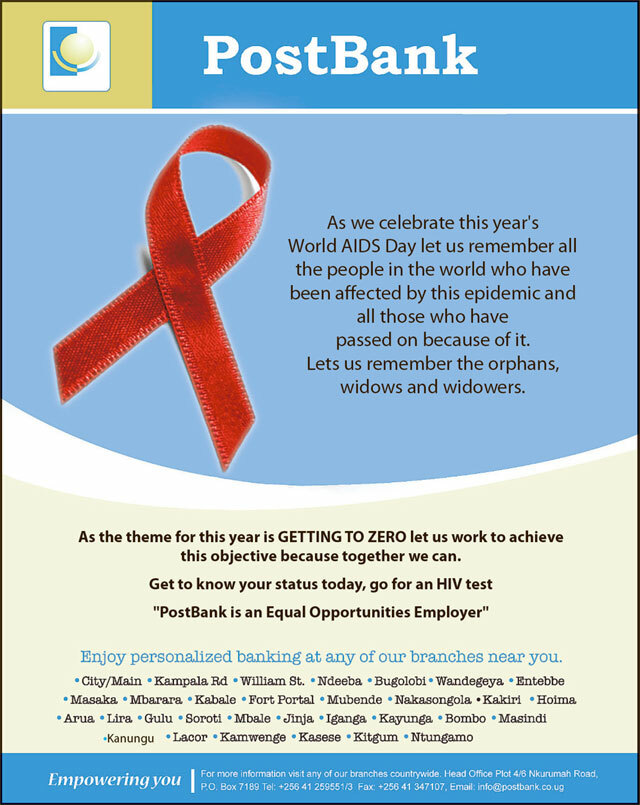Where have all the ARVS gone? World Aids Day Supplement
Dec 02, 2011
Today, Uganda joins the rest of the world to celebrate the World AIDS Day with the theme: “Getting to Zero new HIV Infections, Zero discrimination and Zero AIDS related Deaths.”


Today, Uganda joins the rest of the world to celebrate the World AIDS Day with the theme: “Getting to Zero new HIV Infections, Zero discrimination and Zero AIDS related Deaths.”
The local theme that was selected by the Uganda Aids Commission is “Re-engaging leadership for effective HIV prevention.” Leadership is defined to include individuals, households, communities and institutions to national levels.
By Elvis Basudde
Betty Kyalimpa sits on a bench in a corner of a private clinic in Kampala covering her face with a dirty handkerchief. The visibly weak and tired woman in her mid-30s weeps uncontrollably as she narrates her ordeal.
“I live in Kanungu and for the last four years since I was diagnosed with HIV and put on ARVs, I have been getting my drugs from a health centre 20 kilometers away from my home,” she says.
“But for the last one month, I have gone without medication because the health centre has not had drugs for more than three months now. I have moved to almost all clinics and health centers but they all say the same thing- drugs are out of stock!”
Kyalimpa’s doctor gave her a referral to bring to Kampala with the hope that she could find help, but even here, her woes are not over. Everywhere she goes, she is told there are no drugs for her yet her disease is advancing.
Otim Francis, 30, from Katakwi, says he has not had drugs for two months now because health centres in his home area have not had drugs for months.
Proscovia Namutebi is one of the thousands of individuals who were on treatment but have now been dropped.
She was part of a five-year research study receiving Anti Retroverial Therapy (ART) in Tororo and as many as 1,000 People living with HIV/AIDS (PHAs) were dropped from treatment when the study ended.
“We were told to go back to another provider who told us the number was already too big and they were capped. Many of us have no treatment now,” cries Namutebi.
As is happening in other clinics in Kampala too, most newly infected patients are turned away or put on a waiting list for ARVs. A slot opens when a patient dies.
The death rate in Apac has also increased amongst the PHAs community, who are all clients enrolled on chronic care. According to Denis Mock of the Apac District forum of People living with HIV/AIDS (ADFPHA), 16 PHAs have died since last year.
The drug stock outs have reached unprecedented level making activists wonder whether the HIV/AIDS war is not falling apart.
“Uganda is the first and most obvious example of how we are losing the war on global HIV/AIDS. It is the first country where major clinics routinely turn people living with HIV/AIDS away,” remarks Florence Buloba, executive director, National Community of Women Living With HIV/AIDS.
Uganda’s achievement in responding to the HIV/AIDS epidemic has been acknowledged by the international community, which continues to provide financial, technical and material support to the country to deal with the disease.
But with evidence of increasing new HIV infections coupled with the shortage of drugs, congestion in health facilities, treatment rationing, patients sharing medicines, diversion of funds meant for HIV and limited resource personnel, Uganda may be failing to stop the epidemic.
Government and private HIV treatment facilities have stopped enrolling new patients due to shortage of drugs, caused by recent cuts on funding for HIV/AIDS treatment by international donors especially the US President’s Emergency Plan for AIDS Relief (PEPFAR), World Bank and the Global Fund.
Since the 2008-9 economic crisis in donor countries, donors slapped an informal ban on new patients receiving ARVs. As a result, major providers of AIDS care in Uganda have been scaling down.
The two biggest providers of care to persons living with HIV, Mildmay Uganda and JCRC, closed a number of their satellite sites. These developments left many people living with HIV stranded and others especially in rural areas dying.
“The slow-down in enrolment on treatment means that patients only receive treatment when they already require intensive care for opportunistic infections and AIDS related diseases,” says Major Rubaramira Ruranga, an HIV/AIDS activist.
He says there is a high risk of those people who had been initiated to treatment to stop thus contributing to resistance and in the future, if treatment is to be started, they would need more expensive second line and third line.
According to Dr. Stephen Watiti, 1.3 million Ugandans are living with HIV/AIDS, 120,000 of them children. Out of these, 360,000 are eligible for ARVs because their CD4 count is below 250 cells/mm. And out of these, about only 180,000 (about 40%), are getting ARVs
For nearly a decade, Uganda’s HIV prevalence rate has stagnated around 6.3% and experts warn that it is beginning to rise again in some places. According to the Ministry of Health, there are 140,000 new estimated infections every year.
And there is an epidemic of pediatric HIV cases, with 30,000 newborns infected annually.
Last year, the World Health Organisation (WHO) recommended earlier treatment for HIV positive people, advising doctors to start HIV patients on drugs when their level of CD4 cells is about 350. Before it was below CD4 200.
“If this recommendation is to be fulfilled, at least 740,000 patients out of an estimated 1.1 million Ugandans living with HIV would require anti-retroviral treatment,” says Dr. Watiti.
However, at the moment, only about 200,000 people are on ARVs in Uganda leaving the majority of PHAs in Uganda in a precarious position because many of them already have AIDS or are going to develop it very soon.
“The number of people requiring ARVs will soon outweigh the national capacity to provide them. Even if ARVs have the capacity to prolong life, it is much better and safer to stay negative,” advises Dr. Kihumuro Apuuli, the director general, UAC.
Ironically, the shortage was reported at a time when Uganda’s Quality Chemical Industries, a WHO-accredited pharmaceutical company based in Luzira, started full-scale production of ARVs.
“This development is jeopardising the universal access goals for Uganda and threatening to make new infections even higher,”says Dr. Canon Gideon Byamugisha.
“Fewer people will be motivated to seek for testing services, just as it was in the pre-ART era, where the majority of those living with HIV were only reporting for care in the final stages of their infection,” adds Dr. Byamugisha.

A senior health worker, at JCRC, complained that turning away “desperate patients” on a daily basis due to ARV shortage was the worst challenge of his medical career.
“Loss of donor interest makes me frantic with worry. Once word spreads that there is no treatment for PHAs, they do what they did in the past, go to the witchdoctors and buy fake treatment,” the worker said.
Dr. Stephen Muwonge of an accredited health centre in Masaka says he is still giving free ARVs to a few patients but soon his drugs will run out.
“It makes me sad,” says Muwonge.
“Sometimes we wonder if you are doing people favours. You start them on drugs, you give them hope, and then you are not sure you can keep it up. We all knew these drugs are for life,” he adds.
Dr. Zainab Akol, the manager of the health ministry’s HIV-AIDs Control Programme, attributes the shortage of ARVs to a sharp increase in the number of AIDS patients, with donors unable to match the increase.
An official from Quality Chemicals Industries said they have never suspended producing ARVs since they started in January, and they have the capacity to produce any volume of drugs once orders are given to them by government.
George Baguma, the marketing manager, Quality Chemicals Industries, says they manufacture Anti-retrovirals and Anti-malarials, and deliver drugs that Government has ordered for. It takes the company four months to manufacture, including time for ordering of raw materials, manufacture and analysis.
Activists regret that the number of people getting infected by HIV grows by a thousand every month yet science has produced no miracle either-no cure, no vaccine.
Every proposal for controlling the epidemic with current tools like circumcising every man in the third world, or giving a daily prophylactic pill to every one contemplating sex, is sadly impractical.
In a recent statement, PEPFAR announced minimal increment in its budget from the current $6.8b to $7b for next year.
Byamugisha argues that PEPFAR’s increment is too little to cater for new AIDS patients in over 15 countries that benefit from the programme in Africa and Asia.
“Like our local theme goes, we need to re-engage our leadership for effective HIV prevention,” says Dr. Stephen Watiti.
“There should be transparency in the distribution and supply chain, mis-allocation of funds for ARVs and corruption in the AIDS industry should stop, and the Government should provide CD4 count machines in every district in the country,” he asserts.
